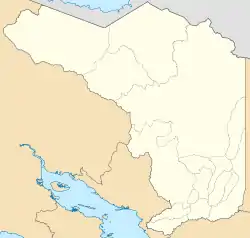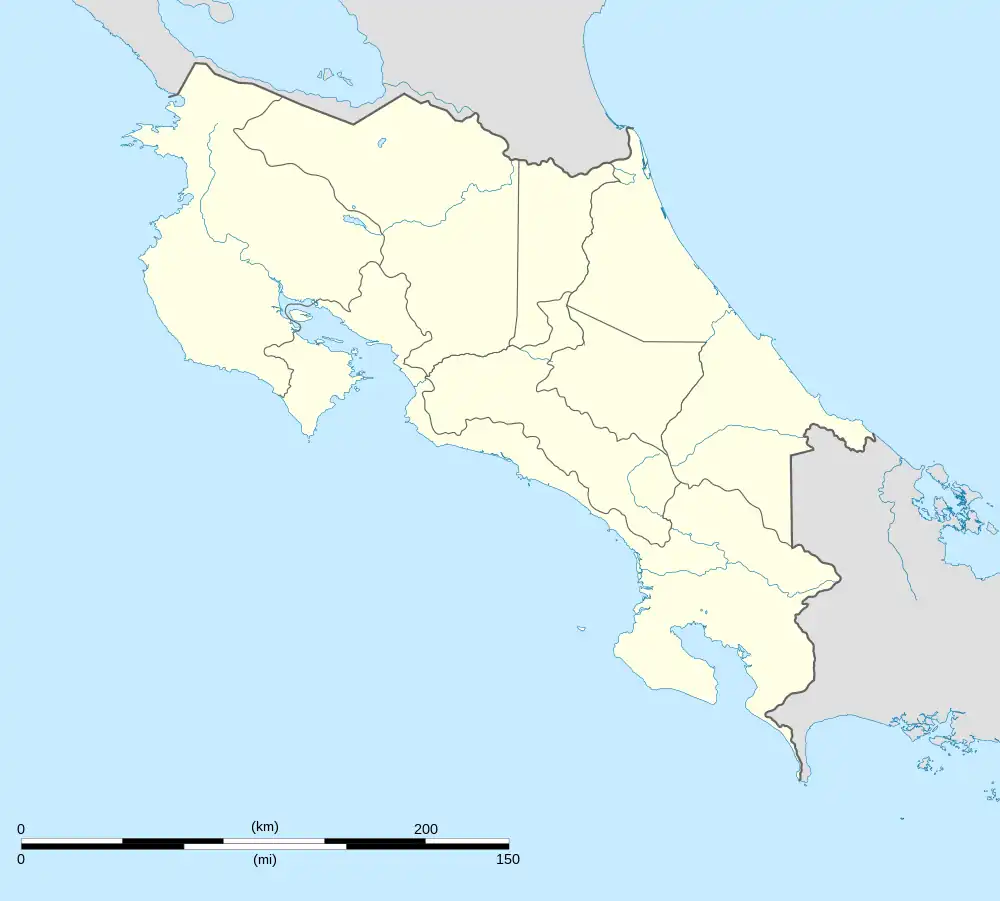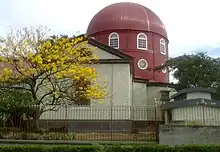Alajuela (canton)
Alajuela is a canton in the Alajuela province of Costa Rica.[2][3] Its head city is the provincial capital city of Alajuela.
Alajuela | |
|---|---|
 Alajuela urban area | |
 Flag  Seal | |
Alajuela canton | |
 Alajuela Alajuela canton location in Alajuela Province  Alajuela Alajuela canton location in Costa Rica | |
| Coordinates: 10.163979°N 84.2645463°W | |
| Country | |
| Province | Alajuela |
| Creation | 7 December 1848[1] |
| Head city | Alajuela |
| Districts | |
| Government | |
| • Type | Municipality |
| • Body | Municipalidad de Alajuela |
| Area | |
| • Total | 388.43 km2 (149.97 sq mi) |
| Elevation | 942 m (3,091 ft) |
| Population (2011) | |
| • Total | 254,886 |
| • Density | 660/km2 (1,700/sq mi) |
| Time zone | UTC−06:00 |
| Canton code | 201 |
| Website | www |
History
Alajuela was created on 7 December 1848 by decree 167.[3]
Geography
Alajuela has an area of 388.43 km²[4] and a mean elevation of 942 metres.[2]
Northward from the city of Alajuela, the canton continues along the border with the province of Heredia to its east, encompassing a strip of the Cordillera Central (Central Mountain Range) between Poas Volcano and Barva Volcano. On the Caribbean side of the mountains, the canton takes in a portion of the Sarapiquí area. The Río Poás (Poas River) forms the major portion of the canton's western border, finally giving way to the Río Poasito as the territory ascends into the Cordillera Central.
Southwest of the city of Alajuela, the canton of Alajuela ends at the confluence of the Río Grande (Great River) and the Río Virilla (Virilla River).
Landmarks

In the center of Alajuela, next to Parque de Alajuela, also known as "Parque de los Mangos", is Alajuela Cathedral, whose main feature is its red dome. This park is a popular place for locals to socialize, especially in the afternoons. One block west of the park is the Mercado Central de Alajuela, a bustling shopping centre. Poás Volcano National Park is about 37 kilometres (23 mi) north of Alajuela city and is known for its five waterfalls at La Paz Waterfall Gardens.[5]
To the north of the Central Park is the Museo Histórico Cultural Juan Santamaría. This museum, situated in a building built in 1894-45, which was formerly a prison in the barracks of Alajuela, contains many historical maps, artifacts and portraits of the 1856-1857 campaign. In 1977 it became the headquarters of the Centro de Investigación para el Perfeccionamiento Técnico (CIPET), an institution of the Ministry of Public Education.[6]
Districts
The canton of Alajuela is subdivided into the following districts:
Demographics
| Historical population | |||
|---|---|---|---|
| Census | Pop. | %± | |
| 1864 | 11,521 | — | |
| 1883 | 15,247 | 32.3% | |
| 1892 | 19,300 | 26.6% | |
| 1927 | 25,656 | 32.9% | |
| 1950 | 37,376 | 45.7% | |
| 1963 | 64,398 | 72.3% | |
| 1973 | 96,325 | 49.6% | |
| 1984 | 127,472 | 32.3% | |
| 2000 | 222,853 | 74.8% | |
| 2011 | 254,886 | 14.4% | |
|
Instituto Nacional de Estadística y Censos[7] |
|||
For the 2011 census, Alajuela had a population of 254,886 inhabitants. [9]
Transportation
Road transportation
The canton is covered by the following road routes:
 National Route 1
National Route 1 National Route 3
National Route 3 National Route 27
National Route 27 National Route 107
National Route 107 National Route 111
National Route 111 National Route 118
National Route 118 National Route 119
National Route 119 National Route 120
National Route 120 National Route 122
National Route 122 National Route 123
National Route 123 National Route 124
National Route 124 National Route 125
National Route 125 National Route 126
National Route 126 National Route 130
National Route 130 National Route 136
National Route 136 National Route 140
National Route 140 National Route 146
National Route 146 National Route 147
National Route 147 National Route 153
National Route 153 National Route 712
National Route 712 National Route 718
National Route 718 National Route 719
National Route 719 National Route 721
National Route 721 National Route 727
National Route 727
Rail transportation
The Interurbano Line operated by Incofer goes through this canton.
Economy
It is a major area for the production of coffee, strawberries and ornamental plants.[10][11] The Doka Estate lies within the canton, in Sabanilla District, and is a major coffee producing estate, supplying directly to Starbucks.[12]
References
- Hernández, Hermógenes (1985). Costa Rica: evolución territorial y principales censos de población 1502 - 1984 (in Spanish) (1 ed.). San José: Editorial Universidad Estatal a Distancia. pp. 164–173. ISBN 9977-64-243-5. Retrieved 5 October 2020.
- "Declara oficial para efectos administrativos, la aprobación de la División Territorial Administrativa de la República N°41548-MGP". Sistema Costarricense de Información Jurídica (in Spanish). 19 March 2019. Retrieved 26 September 2020.
- División Territorial Administrativa de la República de Costa Rica (PDF) (in Spanish). Editorial Digital de la Imprenta Nacional. 8 March 2017. ISBN 978-9977-58-477-5.
- "Área en kilómetros cuadrados, según provincia, cantón y distrito administrativo". Instituto Nacional de Estadística y Censos (in Spanish). Archived from the original on 24 October 2020. Retrieved 26 September 2020.
- Fodor's Costa Rica 2012. Fodor's. November 2011. p. 267. ISBN 9780307929044.
- "Museo (arquitectura)" (in Spanish). Museo Histórico Cultural Juan Santamaría. Retrieved 26 August 2019.
- "Instituto Nacional de Estadística y Censos" (in Spanish).
- "Sistema de Consulta de a Bases de Datos Estadísticas". Centro Centroamericano de Población (in Spanish).
- "Censo. 2011. Población total por zona y sexo, según provincia, cantón y distrito". Instituto Nacional de Estadística y Censos (in Spanish). Retrieved 26 September 2020.
- McNeil, John (2011). The Rough Guide to Costa Rica. Rough Guides. p. 121. ISBN 9781858287133.
- Drew, Keith (2012). The Rough Guide to Costa Rica. Rough Guides. p. 133. ISBN 9781405391993.
- Glassman, Paul (2006). Costa Rica Guide. Open Road Publishing. p. 43. ISBN 9781593600686.